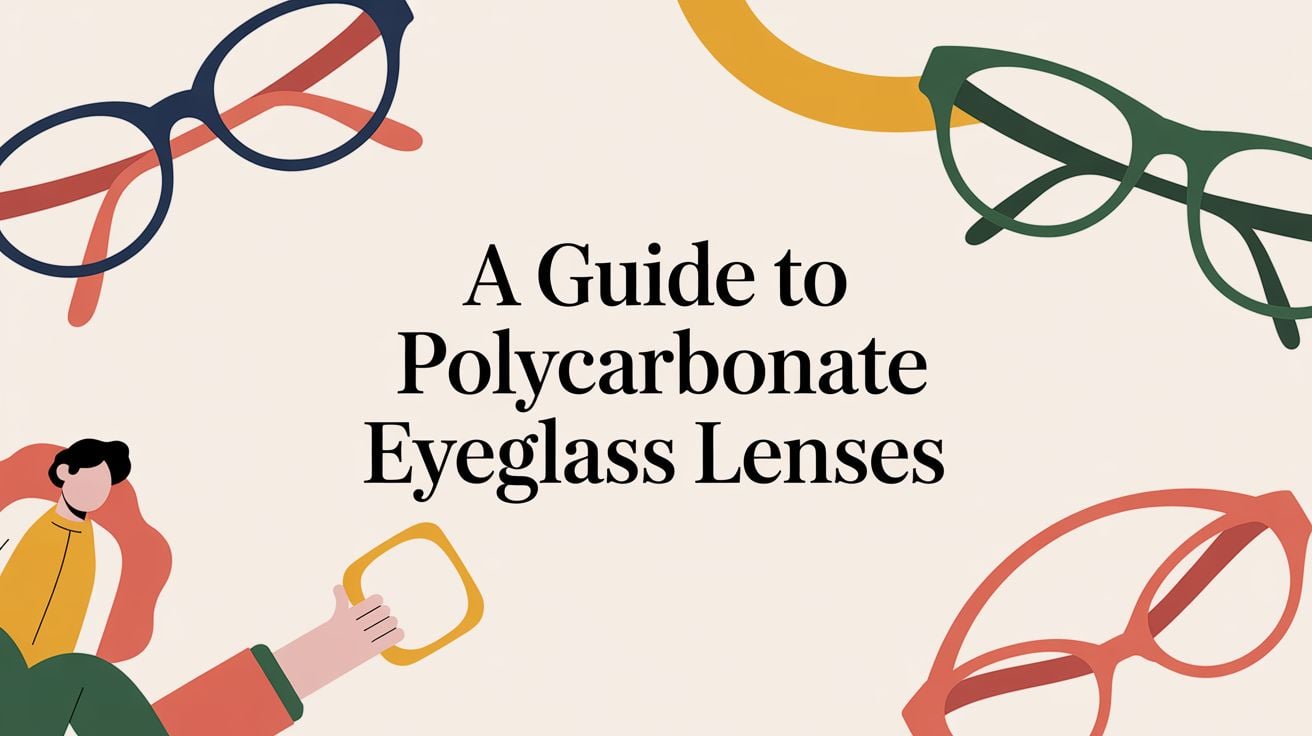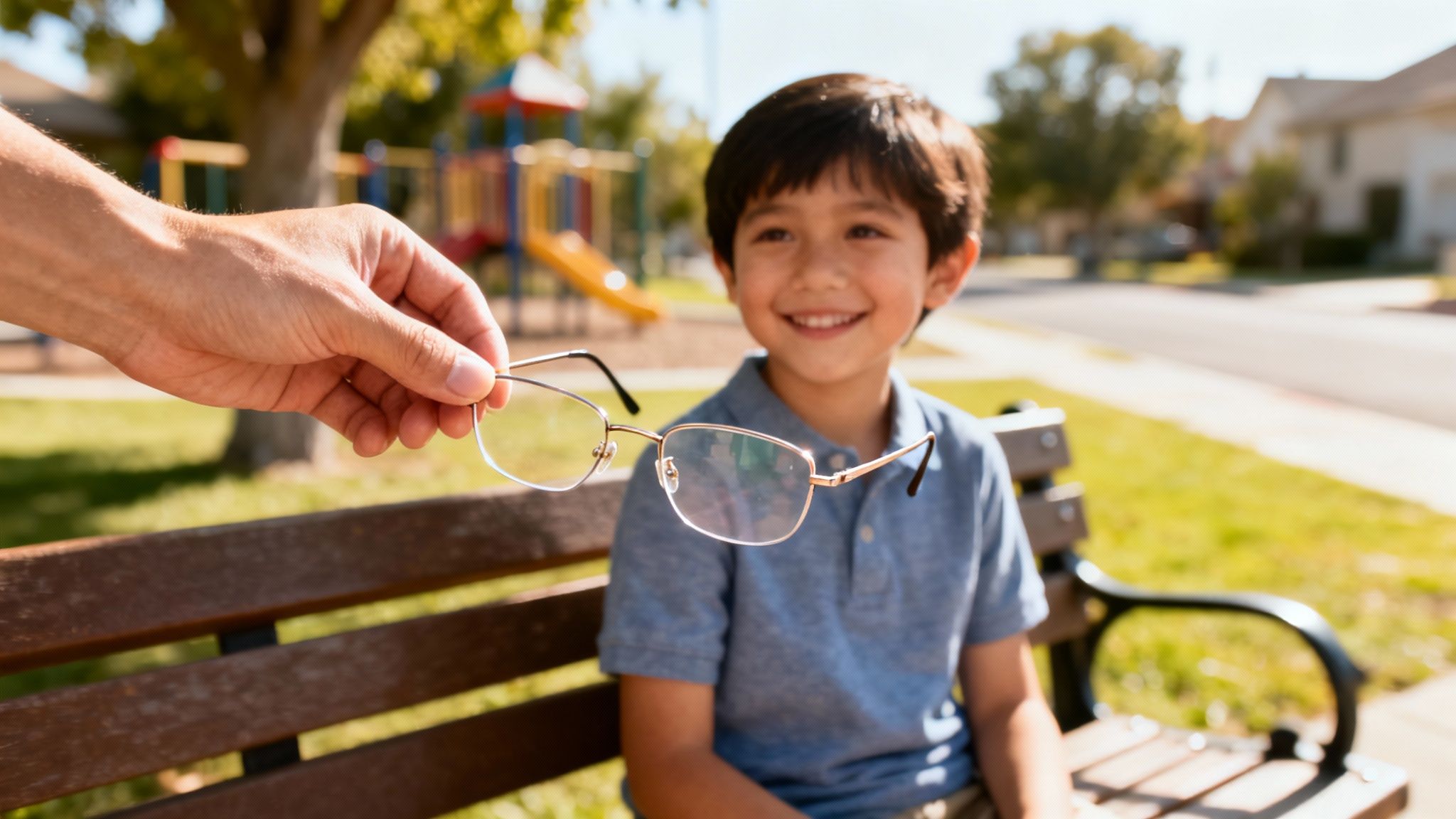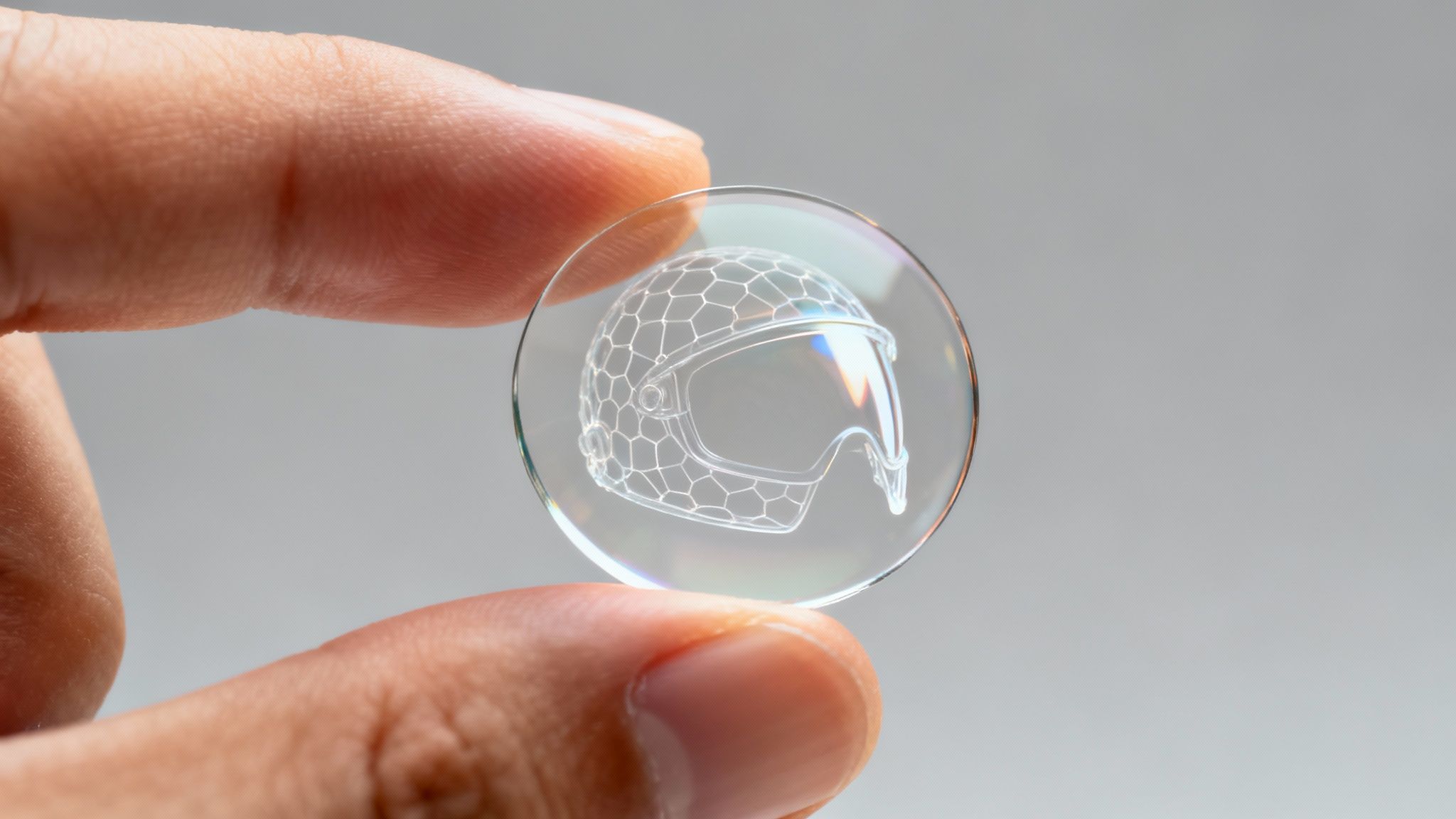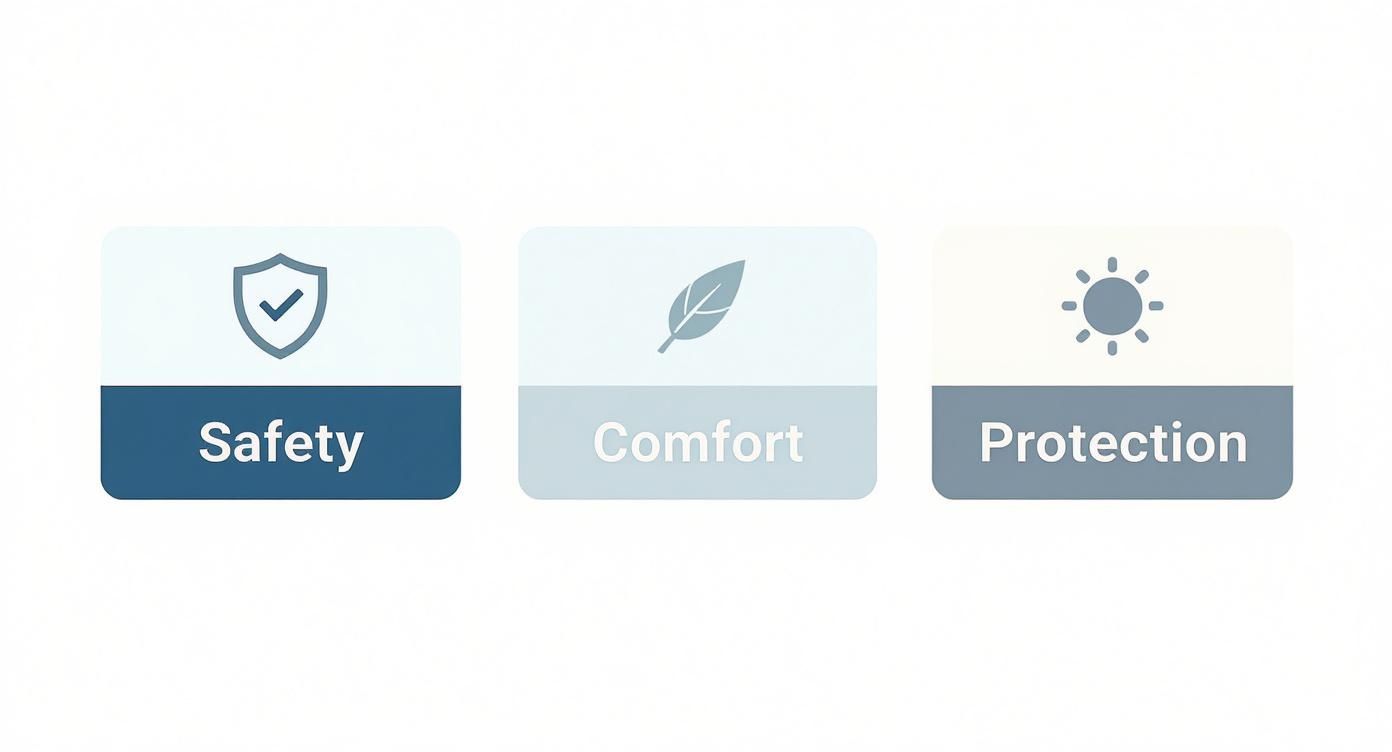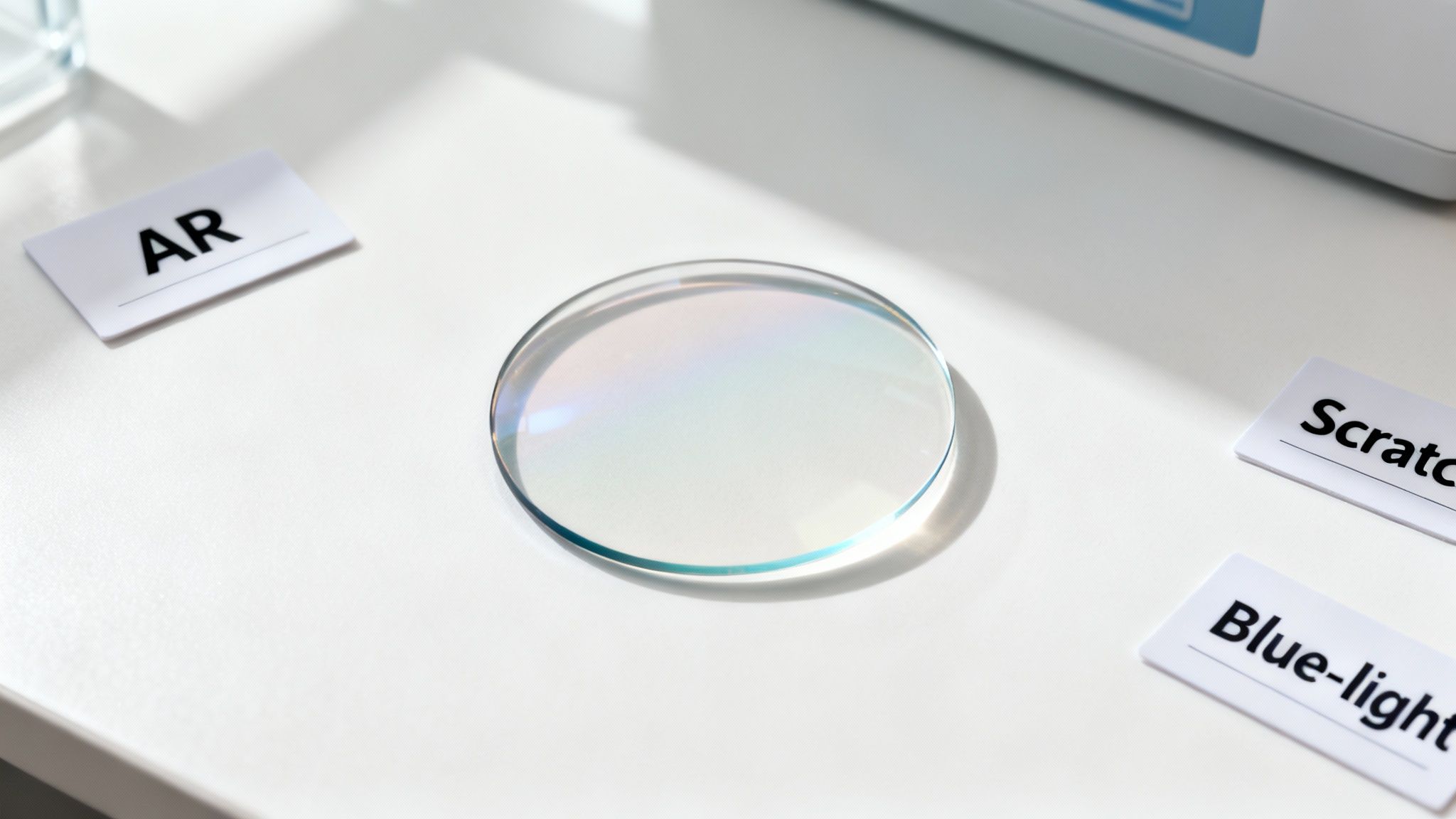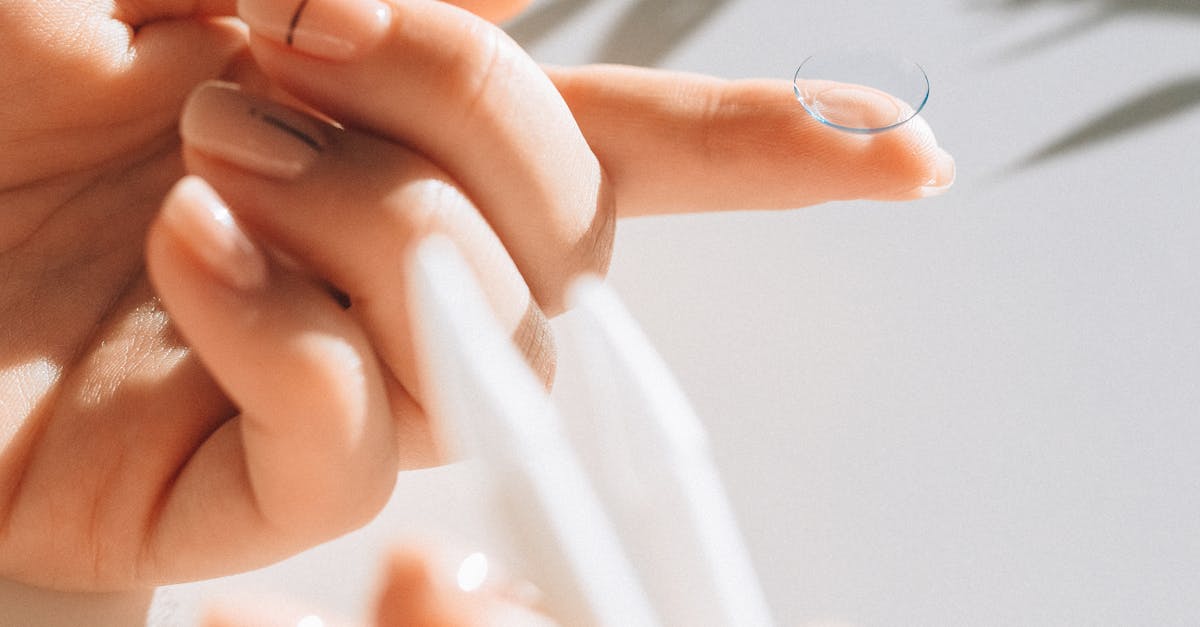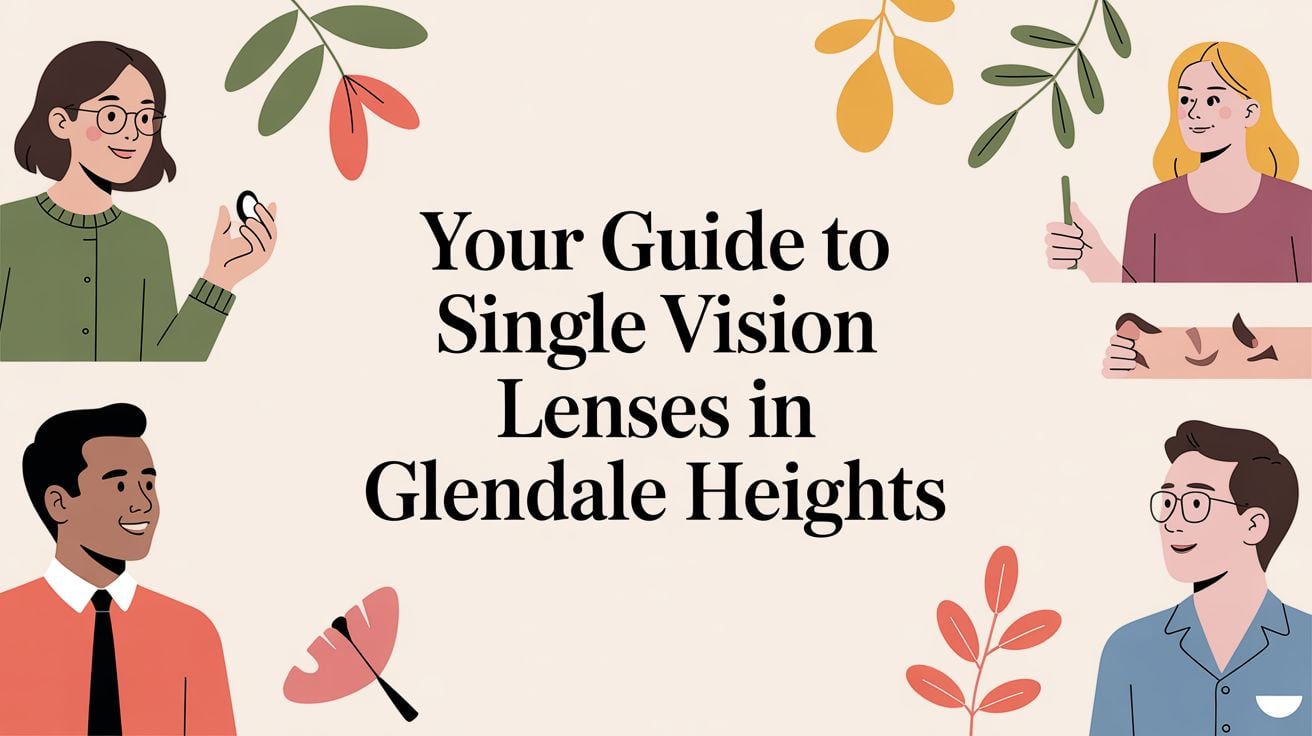Picking the right lenses for your glasses is just as important—if not more so—than finding frames you love. When it comes to modern lens materials, polycarbonate is a standout choice, known for being incredibly tough and remarkably lightweight. For our patients here in Glendale Heights, this advanced material offers a level of impact resistance that's perfect for anyone with an active lifestyle.
Why Polycarbonate Lenses Are a Go-To in Glendale Heights
Think about your daily routine. Maybe you’re navigating the commute down North Avenue, enjoying an afternoon with the kids at Camera Park, or attending a local event at the Glendale Heights Center for the Performing Arts. You need eyewear that gives you crisp, clear vision and the confidence that it can handle whatever the day throws at you. That's where polycarbonate lenses come in.
Polycarbonate delivers a powerful one-two punch of safety and comfort, making it a fantastic solution for so many of our patients here at iDoctor in Glendale Heights. Understanding what makes this material different is the first step toward making a smart, informed decision about your vision.
Here at iDoctor, we want you to feel empowered, not overwhelmed, by your options. Choosing lenses shouldn't be a mystery, so in our warm, approachable way, we’re here to break down exactly why this material is so exceptional. After all, it’s not just about seeing clearly; it’s about protecting your eyes and making sure your glasses feel so comfortable you almost forget they're there.
The Core Benefits of Polycarbonate Lenses
Believe it or not, polycarbonate was first developed for the aerospace industry—think astronaut helmet visors. That same tough-as-nails technology is now available for your eyeglasses, offering a unique set of advantages that are perfect for modern life.
These lenses are really built on three key strengths:
- Superior Impact Resistance: This is polycarbonate’s claim to fame. It’s up to 10 times more impact-resistant than standard plastic or glass lenses, which is why it’s the undisputed champion for safety glasses, sports goggles, and—most importantly—children's eyewear.
- Built-In UV Protection: Sun protection for your eyes is non-negotiable. Polycarbonate material naturally blocks over 99% of the sun’s harmful UV rays without needing an extra coating. It’s a built-in health benefit.
- Lightweight Comfort: Polycarbonate lenses are noticeably thinner and lighter than old-school plastic lenses. This translates directly to all-day comfort, reducing the pressure on your nose and ears.
Think of polycarbonate less as just a lens material and more as an investment in eyewear that’s durable, protective, and comfortable. Its unique blend of strength and lightness makes it one of the most versatile and practical choices on the market.
Your Local Experts in Advanced Lens Technology
Making the right choice for your vision is always easier with professional guidance. At iDoctor, our team specializes in fitting you with the perfect lens solution for your prescription and your lifestyle.
When you come in for one of our detailed eye exams in Glendale Heights, we take the time to really listen to your needs. We'll explore whether polycarbonate is the right fit for your new Ray-Ban or Cartier frames and explain all your options clearly. Our goal is simple: to make sure you walk out of our boutique seeing perfectly and feeling completely confident in your new eyewear. This guide is your starting point for having that knowledgeable conversation with your eye doctor.
Understanding Polycarbonate Lenses
When you hear the term polycarbonate eyeglass lenses, it might sound a bit technical, but the idea behind them is actually straightforward and quite impressive. So, what makes this material so special for your glasses? It all comes down to its incredible strength and surprisingly lightweight feel, a combination that comes from some seriously high-tech origins.
Think about the material used to make astronaut helmets, CDs, or even bullet-resistant glass. That’s the same family of tough, resilient plastic that has been expertly adapted to create crystal-clear, comfortable lenses for your eyeglasses. It’s not just any old plastic; it’s a specific polymer engineered for exceptional impact resistance.
The secret is in its unique molecular structure, which allows it to absorb energy from an impact without fracturing. While standard plastic or glass lenses might crack or shatter, polycarbonate actually flexes to disperse the force. This one difference is exactly why it has become the gold standard for safety eyewear.
From Aerospace to Eyewear
The journey of polycarbonate from industrial uses to your everyday glasses is a great example of smart innovation. It was first developed for industries where safety was an absolute must. It didn't take long for optical experts to see its amazing potential for protecting something we all value: our eyesight.
By refining the material, they managed to achieve excellent optical quality while keeping its legendary toughness. The result is a lens that gives you sharp vision, is remarkably light on your face, and offers a level of protection that older materials just can't compete with. This makes it a fantastic choice for almost everyone, from active kids on the playground to safety-conscious adults on the job.
Knowing this backstory helps you understand why your optometrist might strongly recommend polycarbonate. It’s a choice backed by years of proven performance and safety. To see how it fits in with other options, feel free to explore our full guide to the types of eyeglass lenses.
Why Its Composition Matters for You
The science behind polycarbonate translates directly into real-world benefits for you as a glasses wearer. Its unique makeup is what makes it both incredibly durable and comfortable enough for all-day wear.
At its core, polycarbonate is engineered for resilience. This means your glasses are simply better equipped to handle the accidental drops and bumps of daily life, giving you peace of mind and protecting your investment in quality eyewear.
Here’s a simple breakdown of what its structure means for your vision and comfort:
- Impact Resistance: As we’ve touched on, polycarbonate is up to 10 times more impact-resistant than regular plastic lenses. This is why it’s our top recommendation for children’s glasses, sports goggles, and safety eyewear.
- Thinner and Lighter Profile: For the exact same prescription, polycarbonate lenses can be made noticeably thinner and lighter than traditional plastic ones. This reduces that heavy feeling on your nose and ears, preventing your glasses from constantly slipping down.
- Inherent UV Protection: The material itself naturally blocks over 99% of the sun’s harmful ultraviolet (UV) rays. This protection is built right in, so you don't need to add a separate UV-blocking coating.
Having this foundational knowledge helps you appreciate the real value behind your lens choice. When we at iDoctor recommend polycarbonate lenses, it's because we're confident we’re providing a product that truly excels in safety, comfort, and protection.
The Unbeatable Advantages of Polycarbonate
When we talk about polycarbonate lenses, we’re really talking about three huge benefits all rolled into one: incredible safety, barely-there comfort, and built-in protection. These aren't just selling points; they’re real-world advantages that make a massive difference in how you experience your vision every day, especially for the active families we see here in Glendale Heights.
It's no surprise that this material is gaining so much traction globally. The market for polycarbonate lenses was valued at a staggering $995 million in 2025 and is only expected to climb. Why? Because people everywhere are realizing that you don't have to choose between lenses that are tough and lenses that are light. Polycarbonate delivers both.
Superior Safety for Every Situation
If there's one reason eye doctors like us consistently recommend polycarbonate, it's this: impact resistance. We’re not talking about a small upgrade from regular plastic. Polycarbonate is up to 10 times more shatter-resistant. It's like having a personal bodyguard for your eyes.
This isn't just a "nice-to-have" feature; for some, it's an absolute must.
- For Children's Eyewear: Kids are going to be kids. They run, they fall, they drop things—including their glasses. Polycarbonate gives parents priceless peace of mind, knowing their child’s eyes are shielded by lenses that won’t shatter during a rough-and-tumble day at the park.
- For Sports and Active Lifestyles: Whether you're on the court, on a bike, or working a physically demanding job, your eyes are at greater risk. Polycarbonate is the material of choice for safety glasses and sports goggles for a reason. It can take a direct hit without breaking apart.
Choosing polycarbonate means putting safety first. This is the same stuff used in astronaut helmet visors and bullet-resistant windows, designed from the ground up to offer both clear sight and serious protection. For athletes wanting the best of both worlds, it's also key to know how to choose sports eyewear that combines performance and style.
All-Day Comfort Through Lightweight Design
You know that feeling at the end of a long day when your glasses feel heavy on your nose and ears? Polycarbonate lenses are the solution. The material itself is less dense than standard plastic, which allows us to craft lenses that are noticeably thinner and lighter, even for higher prescriptions.
The difference is immediate. The lighter weight means less pressure, so you won't be constantly pushing your glasses back up. Many patients tell us it feels like they’re barely wearing glasses at all. For anyone who needs their specs from sunup to sundown, this lightweight design is a game-changer.
Built-In UV Protection
We all know we need to protect our skin from the sun, but what about our eyes? One of the best, yet most underrated, features of polycarbonate is its natural ability to block over 99% of the sun's harmful UVA and UVB rays.
This isn't an add-on coating that can get scratched or wear away. The UV protection is an inherent part of the lens material itself. So, every single time you wear your glasses outside, you're automatically shielding your eyes from radiation that can contribute to cataracts and other long-term eye problems. It's effortless, essential health protection built right in.
How Polycarbonate Stacks Up Against Other Lens Materials
Picking the right lens material can feel a bit overwhelming, but it really just comes down to matching the right technology to your life. Polycarbonate is a fantastic all-around choice, but knowing how it compares to the other options out there will help you feel confident in your decision. Our goal at iDoctor is to give you the clear, straightforward information you need to understand the value in every part of your new glasses.
The world of eyeglass lenses is always advancing. Polycarbonate is a huge part of that landscape, a market valued at a staggering $1,535 million globally in 2024 and still growing. This isn't surprising—people want lenses that are tough and light, and polycarbonate delivers.
This visual gives a great snapshot of the core strengths that make polycarbonate such a popular and reliable choice for so many people.
As you can see, it's the combination of these three benefits that creates such a great wearing experience for our patients every day.
Eyeglass Lens Material Comparison
To make sense of the options, it helps to see them side-by-side. This table breaks down the key differences between the most common lens materials we work with.
| Feature | Polycarbonate | Standard Plastic (CR-39) | High-Index Plastic | Trivex |
|---|---|---|---|---|
| Impact Resistance | Excellent | Poor | Fair | Excellent |
| Weight & Comfort | Excellent (very light) | Fair (can be heavy) | Excellent (thinnest) | Excellent (lightest) |
| Optical Clarity | Good | Excellent | Good to Very Good | Excellent |
| UV Protection | Built-in | Requires coating | Built-in | Built-in |
Each material has its place, and the "best" one is truly the one that best fits your prescription, your activities, and what you value most in a pair of glasses.
Polycarbonate vs. Standard Plastic (CR-39)
For decades, standard plastic, also known as CR-39, was the go-to material. It’s still around because it offers fantastic optical clarity, giving you incredibly crisp and sharp vision with almost no distortion.
The trade-off? It’s not very durable. CR-39 can shatter on impact, which is why we almost never recommend it for kids, athletes, or anyone with an active job or lifestyle.
That’s where polycarbonate shines. It’s up to 10 times more impact-resistant, making it the undisputed champion of safety. It's also noticeably thinner and lighter than CR-39, a difference you can really feel by the end of the day. While CR-39 might have a slight edge in pure optics, the safety and comfort of polycarbonate make it a much more practical choice for most people.
Polycarbonate vs. High-Index Plastics
If you have a strong prescription, you’ve probably heard of high-index lenses. These materials are engineered to bend light more efficiently, which means we can make your lenses much thinner and lighter, even with a powerful correction. They’re the key to avoiding that thick, "coke-bottle" effect.
Polycarbonate is technically a mid-index material. For stronger prescriptions, high-index plastics will give you an even thinner profile. The catch is that they are more brittle than polycarbonate and don’t offer the same level of impact resistance.
For patients with very high prescriptions, a high-index lens offers the best cosmetic appearance. For those with mild to moderate prescriptions who prioritize durability, polycarbonate remains the top contender.
Polycarbonate vs. Trivex
Trivex is a newer material that's a direct competitor to polycarbonate, and for good reason. It also provides incredible impact resistance, is exceptionally lightweight, and has UV protection built right in. It’s an amazing material for safety glasses, sports goggles, and kids’ eyewear.
So, what’s the difference? It really comes down to optical clarity. Trivex has a higher Abbe value, which is just a technical way of measuring how much a lens disperses light into its component colors. A higher value means less "chromatic aberration," or that subtle color fringing you might see around the edges of objects.
While most people would be hard-pressed to notice the difference in daily wear, someone who is very sensitive to visual details might prefer the slightly crisper optics of Trivex.
Ultimately, choosing the right lens is a conversation about balancing these different factors. Seeing how prescription lens technology improves comfort and clarity is the first step, and our team at iDoctor is here to guide you through the rest. We’ll help you find that perfect fit.
Enhancing Your Lenses: Coatings and Upgrades Make All the Difference
Think of a basic polycarbonate lens as the sturdy, reliable frame of a car. It gets you where you need to go safely. But the real magic happens when you add the finishing touches—the coatings and upgrades that customize the ride for your specific needs. That's exactly what specialized lens treatments do for your vision.
These aren't just cosmetic add-ons. They're powerful, functional layers designed to tackle real-world visual annoyances, protect your eyewear investment, and adapt your glasses to your daily life. Here at iDoctor, we help you sort through the options to build the perfect lens from the ground up.
The Must-Have: Anti-Reflective Coating
If you're going to get just one upgrade for your polycarbonate lenses, this is it. An anti-reflective (AR) coating is a microscopically thin layer that works wonders by knocking out the reflections that bounce off the front and back of your lenses.
The improvement is immediate and dramatic. AR coatings allow more light to pass directly to your eyes, which sharpens your vision. They also make your lenses look almost invisible, so people can see your eyes without that annoying glare. It’s a game-changer for night driving, cutting down on those distracting starbursts from headlights you see on roads like Army Trail Road.
Built-in Durability: Scratch Resistance
Here’s a little secret about polycarbonate: while it’s incredibly tough against impact, the raw material is actually quite soft and can pick up surface scuffs easily. This is why a top-quality, scratch-resistant coating isn't just an option—it’s an absolute must to protect your investment.
This hardy coating acts like a protective shield, hardening the lens surface against the inevitable drops, wipes, and bumps of everyday life. It keeps your vision clear and unobstructed, ultimately extending the life of your glasses and giving you real, lasting value.
Combat Digital Eye Strain With a Blue Light Filter
Let's face it, we spend hours staring at screens—computers, tablets, phones. All these devices emit a high-energy blue light that can lead to tired, achy eyes, headaches, and even mess with your sleep.
When looking at lens enhancements, adding blue light protection for lenses is becoming essential for anyone who uses digital devices regularly. This specialized filter helps ease the strain on your eyes, making those long hours in front of a screen much more comfortable.
Think of lens coatings as the final, perfecting touch on your eyewear. They address specific visual needs—from reducing nighttime glare to making screen time easier—transforming a standard pair of glasses into a highly personalized tool for better vision.
Lenses That Adapt: Photochromic Technology
Photochromic lenses, which you probably know by the brand name Transitions®, offer incredible convenience by automatically adjusting to light. Indoors, they’re perfectly clear. Step outside into the sun, and they darken into a comfortable sunglass tint.
This technology essentially combines two pairs of glasses into one. Whether you’re walking out of the office for a lunch break or heading for a walk at East Branch Forest Preserve, your eyes are instantly protected and comfortable. This kind of functional upgrade is a huge reason the global market for these lenses is projected to hit around $5.8 billion by 2032. People want glasses that do more.
Finding Your Perfect Lenses at iDoctor in Glendale Heights
Choosing the right eyewear is about so much more than just the numbers on your prescription. It’s about finding a solution that truly fits into your life. We've walked through all the incredible benefits of polycarbonate eyeglass lenses in this guide—from their nearly bulletproof impact resistance to their lightweight, forget-they're-on-your-face comfort. These are the features that make them the go-to choice for active kids, busy adults, and anyone who demands both safety and style.
But here’s the thing: even the most advanced lens material only works its magic when it's perfectly matched to you. Getting that effortless, crystal-clear vision really starts with a professional consultation and a precision fitting. That’s the foundation of everything we do here at iDoctor. Our commitment to genuinely personalized care is what makes us the best optometrist in Glendale Heights.
The iDoctor Difference Your Vision Deserves
We believe exceptional eye care simply can’t be rushed. It requires time and a keen eye for detail. That's why we always dedicate a full 30 minutes to our detailed eye exams in Glendale Heights. This gives us the time we need to not only get your prescription exactly right but also to talk about your daily routines and visual demands, ensuring the lens technology we recommend is the perfect fit for your life.
A precise prescription is the starting line, but the race is won by pairing it with the right frames and lenses. Whether you’ve got your heart set on a timeless pair of Ray-Bans or an elegant Cartier frame, our skilled opticians will make sure your new polycarbonate lenses are crafted and fitted flawlessly. We're here to guide you through the world of prescription lenses and coatings, helping you create eyewear that doesn't just look incredible but performs even better.
At iDoctor, our mission is to blend clinical precision with boutique service. We offer the advanced technology you'd expect from a top optometrist, but with the curated, personalized experience you truly deserve.
Your Invitation to Clearer Vision
For our neighbors in Glendale Heights and the surrounding Chicagoland suburbs like Bloomingdale and Carol Stream, the journey to perfect vision is just a short drive away. There’s no reason to settle for a one-size-fits-all approach when it comes to something as important as your sight. Come see for yourself what a difference expert guidance, advanced lens materials, and a genuine commitment to your unique needs can make.
We invite you to schedule your appointment at iDoctor today. Let us show you how the right pair of polycarbonate lenses can change not just how you see, but how you experience your world. Your eyes are worth it.
FAQ: Your Top Questions About Polycarbonate Lenses
Making the right choice for your vision can feel overwhelming, but it doesn't have to be. Here are some of the most common questions we hear from our patients right here in Glendale Heights about polycarbonate lenses, answered directly by our team at iDoctor.
Are polycarbonate lenses usually covered by my vision insurance?
Yes, they often are. At iDoctor, we are proud to accept all major vision insurance plans. Most policies recognize polycarbonate as a standard, essential option, especially for children's glasses and safety eyewear. For adults, the specifics can depend on your individual plan. Our knowledgeable team will gladly review your benefits with you to explain exactly what’s covered and ensure you get the most out of your insurance.
Can I get polycarbonate lenses in designer frames like Gucci or Prada?
Absolutely! In fact, polycarbonate is a perfect match for the high-end eyewear we carry from luxury brands like Cartier, Gucci, Tom Ford, and Prada. Its thin and lightweight profile means it won’t weigh down or distort the look of a beautifully designed frame. When you're looking for designer eyeglasses in Glendale Heights, our expert opticians will take precise measurements to ensure your lenses are cut perfectly, creating a seamless look that combines elite style with crystal-clear vision.
Why does every eye doctor in Glendale Heights recommend polycarbonate for kids?
It all comes down to safety. Kids are constantly on the move, and their glasses need to be tough enough to handle everything from playground tumbles at local schools to sports practice. Polycarbonate is up to 10 times more impact-resistant than standard plastic, meaning it won't shatter if it takes a hit. This incredible durability, combined with its built-in UV protection, makes it the undeniable gold standard for protecting a child's developing eyes.
Ready to experience the clarity and comfort of expertly fitted eyewear? Trust the team at iDoctor to guide you through every step. We are Glendale Heights’ premier destination for exceptional eye care and designer eyewear.

